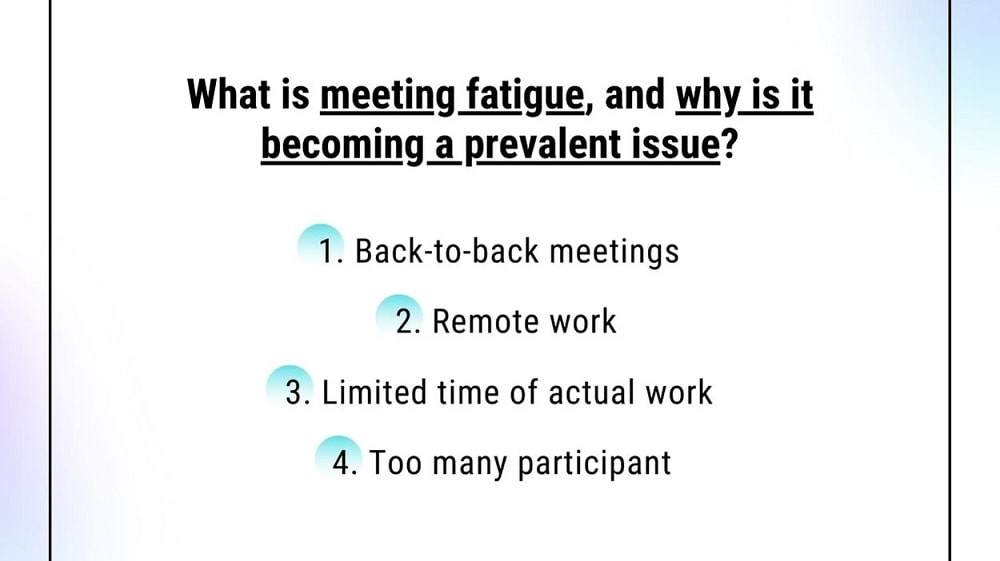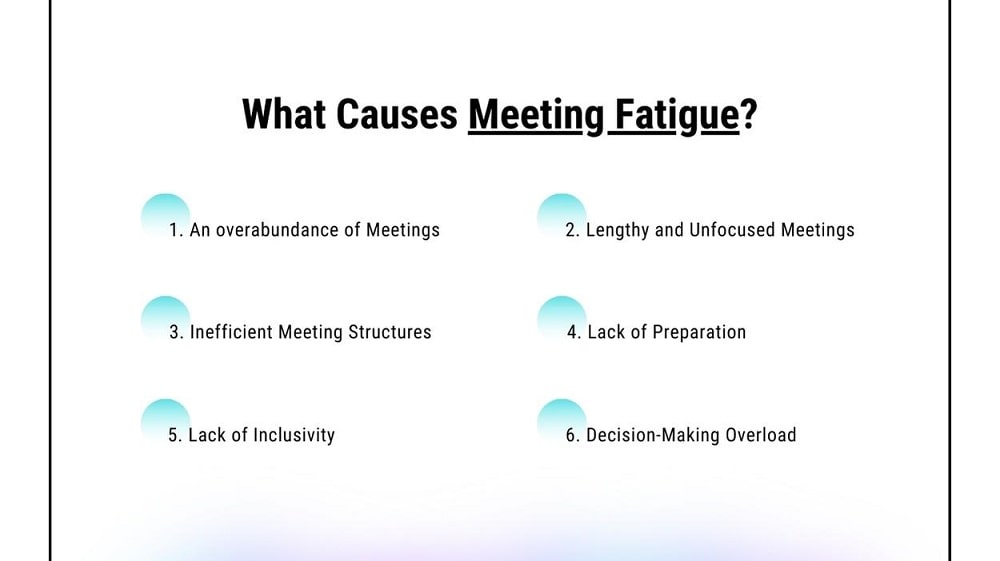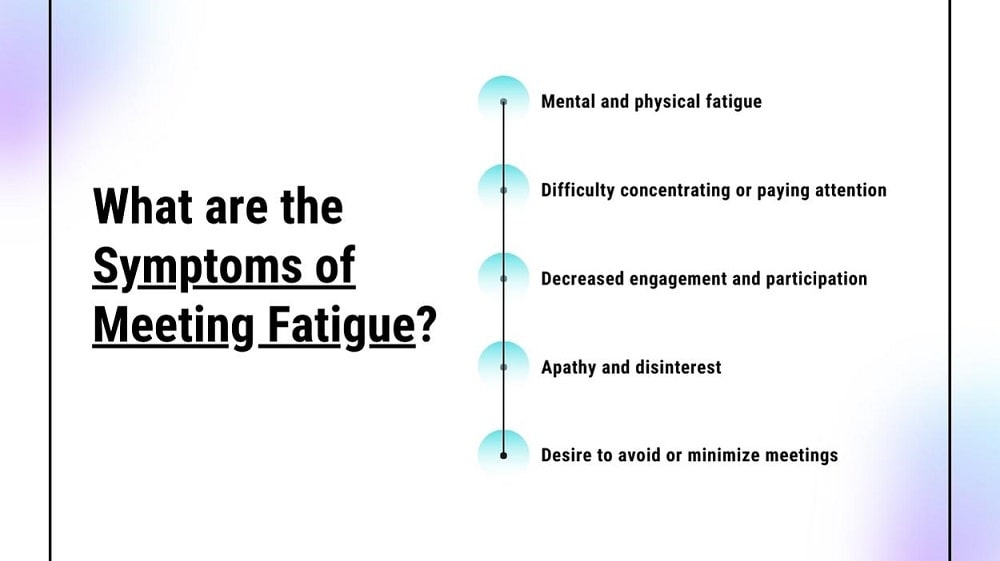Do you usually find yourself drained and mentally tired after a lengthy day full of back-to-back meetings?
If so, you are not alone. In today’s fast-paced and interconnected work environment, meeting fatigue has emerged as a growing concern for professionals across various industries.
According to Stanford, one in seven women – 13.8% – compared with one in 20 men – 5.5 % – reported feeling “very” to “extremely” fatigued after virtual meetings.
This alarming statistic sheds light on the growing concerns surrounding the impact of remote work on individuals’ well-being and productivity.
Furthermore, productivity takes a hit as attendees find it challenging to retain crucial information or contribute effectively amidst the never-ending cycle of discussions. As a working professional, I also have experienced the detrimental effects of meeting fatigue.
But you do not need to worry, as this post will provide you with complete information on meeting fatigue symptoms, how to tackle it, and how you, as a manager, can help employees.
Let’s take that first step, shall we?
What is meeting fatigue, and why is it becoming a prevalent issue?

Meeting fatigue is a physical condition when a person feels mentally and physically tired. This can be due to various reasons, such as doing non-stop online meetings, collaborating virtually for a long period, or constantly looking at the screen during online conferences.
Nowadays it has become quite prevalent, because of these reasons:
👉 Remote work
Thanks to the pandemic, now most of the professionals are working remotely. However, a virtual way to communicate makes you constantly look at the screen, which leads to meeting fatigue.
👉 Back-to-back meetings
You may be in a senior position or handling an important project, making you receive or make video meetings back to back, which can give you both mental and physical exhaustion.
👉 Too many participants
Having too many participants in the virtual meeting causes confusion and reduces the overall value of the meetings, and ultimately contributes to fatigue.
👉 Limited time of actual work
Since the frequency of virtual meetings is high during remote work, there is very little time left for the actual work, which increases the employee’s workload and makes them feel stressed.
What causes meeting fatigue?

Meeting fatigue is physically and mentally draining for a person handling both professional and personal life. This can be caused due to several reasons, which I have explained below so you as a manager can identify and rectify it as soon as possible.
1. An overabundance of meetings
One of the big culprits behind meeting fatigue is the lot of conferences people are expected to participate in. When timetables are swamped with back-to-back meetings, it leaves little time for an actual job and individual restoration. Continuous context-switching can reduce focus and raise stress and anxiety, affecting total efficiency and wellness.
2. Lengthy and unfocused meetings
Meetings that extend beyond their designated durations or do not have a clear agenda usually tend to be much more stressful. Individuals might be entrapped in discussions that divert off-topic or need concrete results. The lack of direction can result in irritation and a sense of wasted time, contributing to meeting fatigue.
3. Inefficient meeting structures
Inadequately organized meetings, without specified duties or moderation, can lead to turmoil. When attendees need clarification concerning their responsibilities or the meeting’s purpose, they might disengage or become passive observers, leading to disconnection and tiredness.
4. Lack of preparation
Meetings become ineffective when individuals are not adequately prepared. Access to appropriate materials or sufficient background details is required for participants to contribute meaningfully. This unpreparedness can result in the absence of engagement, making the meeting fruitless and draining for the individuals involved.
5. Lack of inclusivity
Meetings that do not foster an inclusive environment can lead to fatigue, especially for marginalized individuals. When certain voices are consistently ignored or overshadowed, attendees may feel disconnected and discouraged from actively participating, resulting in mental fatigue.
6. Decision-making overload
Meetings frequently involve decision-making processes that need consideration and evaluation. Nonetheless, if decision-making is continually delayed or stretched, it can contribute to feelings of irritation and ineffectiveness, causing meeting tiredness.
Read more: Feeling Exhausted, Drained? 10 Ways To Beat Decision Fatigue At Work.
Now that you know what causes meeting tiredness, let’s discover some of its vital signs and symptoms. So, you can recognize whether you or your team are experiencing this issue and can take proactive steps to overcome it.
What are the symptoms of meeting fatigue?

People dealing with fatigue certainly show some signs of symptoms. But identifying the right one can be confusing and challenging. So, to provide you with the correct information based on my experience, I am sharing these common symptoms that I have encountered in my team.
➡️ Mental and physical fatigue
After attending numerous conference meetings, you might feel mentally drained and physically tired, which can negatively impact your efficiency and total wellness.
➡️ Difficulty concentrating or paying attention
During meetings, especially if they are lengthy or back-to-back, you might find it challenging to maintain focus, making it harder to engage in the discussions fully.
➡️ Decreased engagement and participation
Throughout conferences, specifically if they are extensive or back-to-back, you could find it challenging to keep emphasis, making it harder to participate completely in the conversations.
➡️ Apathy and disinterest
If you’re experiencing meeting tiredness, you may display symptoms of apathy or disinterest in the topics of the discussion, reducing readiness and involvement.
➡️ Desire to avoid or minimize meetings
A strong desire to avoid or limit presence in meeting conferences can be a considerable sign of meeting tiredness. This could result in you declining meeting invites or looking for alternative communication approaches to manage the fatigue.
You do not need to worry if you are having any one of the symptoms because next, I am going to share with you some practical recommendations on meeting fatigue.
How to combat virtual meeting fatigue?
As the frequency of online meetings increases, an individual’s productivity, motivation, and well-being take a toll. Therefore, it becomes essential for leaders and managers to discover the methods that make your meeting encouraging and interactive.
But how can you do that?
Below I have shared some key solutions to this problem:
7 Effective ways to streamline meeting processes
1. Set the objective clear
Before conducting the meeting, share the details of the meeting and the set objectives. Share these goals with all attendees beforehand so they can have proper preparedness and focused discussion. Doing this ensures that the meeting remains on the set goals and avoids getting it off track, ultimately making the most of everyone’s time and effort.
2. Set the schedule
Create a complete schedule that lists the discussion topics and allotted time for each designated presenter and discussion leaders. Moreover, ensure to share the schedule and the outline in advance, enabling participants to join the meeting promptly and minimizing the risk of time extension.
3. Limit the attendee list
Invite only those individuals who are important to that particular meeting. This way, only suitable people are present, thereby minimizing any potential time-wastage of the other individuals. However, to keep everyone informed about the task, you can share the task update with them via email or through a comprehensive summary.
4. Timeboxing
Specify the time limit for each topic to be discussed. It encourages participants to stay focused and contribute. If the topic is to be discussed in-depth, you can schedule another follow-up meeting rather than getting off track from the current meeting objective.
5. Leverage technology
Another effective way to reduce virtual meetings is to use team collaboration tools. These tools reduce the need for virtual meetings, as they provide a centralized platform to share feedback, real-time communication, and task collaboration, ensuring everyone is on the same page and feels at ease.
6. Take a break
Taking frequent breaks throughout the day can limit virtual meetings fatigue. After each meeting, turn off your system, give rest to your body, and allow yourself to recharge. If possible, you could also go for a walk to change your environment. This way, your employees or you can reduce fatigue and contribute to their best possible contribution.
7. Avoid meetings
Avoiding meetings can be tough, especially when you and your employees fully work remotely. But you could prioritize essential meetings and use other means of communication to convey information.
Read more: Zoom vs. Webex: The Ultimate Showdown.
Role of leadership in curbing meeting fatigue
As a leader, you know that you are also responsible for handling your team’s meeting fatigue. But prioritizing the meeting over the other is not a piece of cake. That directly relates to meeting fatigue in your employee.
Fret not! Let me present you with efficient techniques to tackle this problem.
✅ Encourage timeliness and adherence to schedules: Respect the time of the employees and always follow the schedule of the meetings when initiating and concluding. This way, your employee has not had to go through lengthy meetings and procedures and can focus on their task.
✅ Empower employees to voice concerns: You can also consider forming an environment where everyone on your team can share their perspective regarding the meeting, whether for the time limit or its frequency. Most importantly, always be genuine and unbiased towards their feedback to make necessary changes.
✅ Supporting work-life balance: You can avoid having meetings past working hours, as employees have to stretch their working hours and compromise with their commitments. As a leader, you try to conduct meetings with your team earlier to maintain their work-life balance.
✅ Implement meeting-free time blocks: You can also consider adding some designated period in each working day schedule where there are no meetings. This will empower your employee to concentrate on their personal task, further boosting their productivity and reducing burnout.
✅ Prioritize employee well-being: Being the leader, your employee’s well-being should be your priority. So, to ease back-to-back meetings, you can provide them breaks so they can relax and rejuvenate for their next task.
✅ Assess meeting necessity: Before finalizing the meeting schedule, you must evaluate its purpose and determine if the goals could be achieved through any other communication medium.
✅ Leverage technology for effective communication: Integrate modern digital collaboration tools in your workflow to enhance your communication and minimize the dependencies on virtual meetings. Moreover, with these centralized communication platforms, you can empower your team with greater control over their work and schedule.
Are we heading towards a no-meeting work culture?
Virtual meetings are common these days. However, this trend has presented many challenges for people working in organizations, resulting in exhaustion, overwhelm, and affecting overall productivity. This has forced many companies to follow a no-meeting work culture. One of the best examples is Shopify, where employees can decline virtual meeting invitations.
But one important thing to note here is that many companies have not completely stopped virtual meetings. Instead, they have started using the latest technology, such as team collaboration tools and other innovative software, to reduce the use of virtual meetings. This approach has eased the burden of the employee dealing with fatigue and has given the company a competitive edge.
Read More: How to Create a Safe Space at Work?
Tackle meeting fatigue with innovative solutions
So far we have gathered enough information about meeting fatigue and got to know about its effects and solution. Now, you can deal with this issue on the face with the practical ways shared above.
Meeting fatigue is not something that you should spend your day dreading. You just have to tackle it correctly. The goal is to plan, schedule and run meetings that result in productive actions, without wasting anyone’s time and effort.




















No Comments